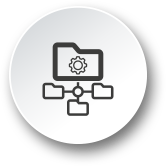
HOW DOES SIFTING WORK
Sifting can be simplified into 5 steps (or ‘sifts’) that can be repeated as required in order to thoroughly analyse and optimise processes. We can re-sift processes in order to see whether optimisations work as intended, and do not create new issues.

SIFT 1 – DEFINE
To effectively apply sifting to a business process, we start with defining: What is the research question or problem and which processes are involved in this? Is efficiency the main focus or is compliance more important? Business- and process experts help to exactly define the problem and the main focus. Required data sets per process, as well as start and end points of the process and (seemingly) key process steps are determined.

SIFT 2 - EXTRACT
Extracting the right data is essential. Which information systems are relevant and how is the data structured? Does the data meet the requirements? Often multiple data sets are used, each having a different data structure. This data will be combined and enriched in order to create useful event logs.

SIFT 3 - ANALYSE
The process mining tool Disco analyses the event logs with smart algorithms. Each intermediate step and exception that a sound mind overlooks, are flawlessly registered in the tool. The process maps and animations accurately shows what really happens in your organisation. Is the predefined process flow being followed (conformance checking)?

SIFT 4 - PRESENT
During an interactive session with process experts and Sifters we determine which problems really affect efficiency and compliance objectives, as well as which risks should be excluded. Where required, sift 2 and 3 are repeated in order to answer specific questions.

SIFT 5 - IMPROVE
Process experts and Sifters lean experts develop plans for improvement that are easy to put in practice for everyone. When executing the plans, continuous monitoring takes place to determine whether the desired objectives are achieved, and where further improvement is possible. Sift 2 to 4 can be repeated for monitoring the results or to determine additional improvement plans.